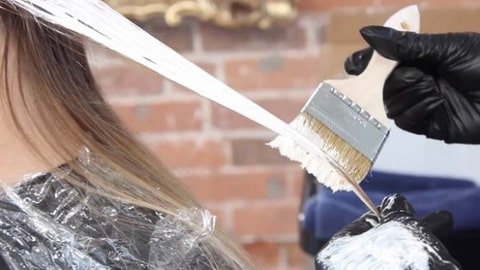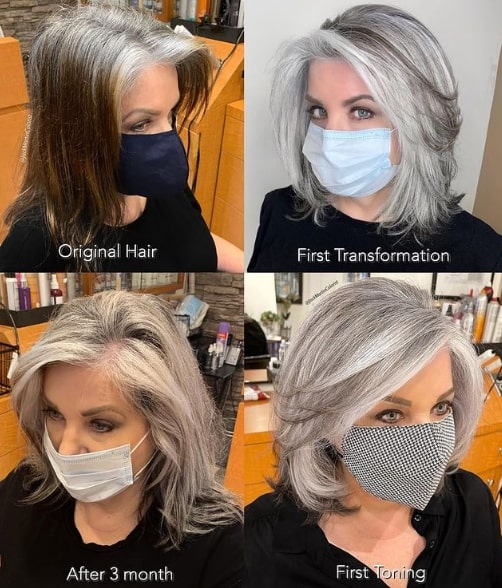Many people rely on permanent color to cover up or fight gray hair. But, recently, women are now embracing ways to go gray gracefully. People currently disguise their gray hairs via a blend of highlights like balayage rather than using permanent cover-ups.
Natural hair enhancement, such as gray hair coloring, is becoming trendy and easy to maintain. Read further to learn how to blend gray hair with the balayage technique.
What is Balayage
Balayage is a highlighting hair technique whereby colorists paint dye in such a way as to create a natural-looking effect. The balayage coloring technique entails hand-painting random hair sections for a graduated style. The approach enhances gray blending and facilitates a smooth transition to gray hair.
The balayage technique follows a freehanded painting approach. The lightener is first applied and then processed in the open air while covered with a plastic film. First, large sections of hair get lightened with a light balayage. Then the colorist accentuates the effect on a few finer strands to blend with the naturally occurring gray strands.

Balayage coloring is fairly light and needs minimal maintenance. Thus, undertaking the technique on your hair helps minimize visits to the hairdresser for up to months. In addition, colorists can intensify silver shades once the hair fiber fades.
Is Balayage Good for Greying Hair?
Yes, Balayage offers an incredible solution for gray hair. It is a smart technique because it allows the colorist to focus on gray strands without touching the scalp. In addition, mixing sections of balayage and highlights can help offset or accentuate your gray strands for an enhanced, natural, low-maintenance look.
Balayage follows the same traditional rule. The highlights are subtly applied a few inches from your roots to brighten and illuminate the strands. Unlike traditional highlights, balayage techniques incorporate multiple benefits as follows:
- The balayage technique allows stylists to cover a large surface area on the client’s hair. Thus, it deters from leaving out much gray hair while creating a natural and youthful look on the client. In addition, the approach creates light and shade throughout the hair.
- The balayage technique allows customization of the treatment to fit clients’ needs. As a stylist, you can control the coverage as the client requires. You can spot-treat certain areas that call for more attention.
- It is easy to maintain the resulting natural look. The freehanded application paired with root smudge provides adequate time between touch-ups, resulting in a natural-looking blend at the root.
Related: Best Eyebrow Color for Gray Hair
How Do You Blend Gray Hair With Balayage?
Balayage is a hair transition approach aiming to get old, dark ends as light as the roots while matching the gray hair tone. You can do gray blending on any original color. The balayage technique involves several steps as follows:
- Stylists start by hand painting lighteners onto random sections of the hair. Here colorists ensure the paint is applied right up to the root to develop a blended finish. The extent of highlighted sections varies depending on the coverage that the client needs. Primarily, the more gray hair, the smaller the sections applied. More customized sections are suitable for larger and lighter coverage.
- Complete the technique by applying a root smudge or color melts to help create a natural, long-lasting blended finish.
Here is a guide video showing the balayage transition to gray hair.
How do Salons Transition to Gray Hair?
The initial process involves stripping off the old treatment with a hair remover. Then, lighten the hair using the lightest shade of blonde possible. Stylists also add a base layer to the lightened strands. Ensure the lightening procedure is appropriately done because if it’s overdone, it can lead to hair break-off.

Different salons may follow varying approaches to blend gray hair. Transitioning your gray hair varies depending on present treatments, hair length, and natural hair color. You might require several salon visits to transition from color-treated hair to natural gray.
How to Blend Grey Hair with Dark Brown Hair
You can blend gray hair with dark brown hair with lowlights. This is a gentle approach, whereby the transition to gray involves sections of hair getting dyed a few shades darker than the natural base. Stylists partake in the process by adding scattered lowlights to blend with natural gray into dark brown. The shade variation lets your gray hair blend beautifully with other strands.
How to go Gray Without Looking Old
Gray hair is one of the most popular trendy hair colors. You can visit your salon colorist for a balayage treatment if you want to go gray. Let your colorist mist a shade that matches your natural gray strands. Smudging your roots ensures a transition between hues and growing roots.
If your hair is dyed a dark color, you may require bleaching it until you attain a light blonde color. Light blonde color provides the base color required for balayage and hides your gray strands.

Aging hair experiences changes such as appearance, thickness, color, and shine. Therefore, protecting and keeping your aging hair healthy with color-safe shampoo and moisturizing conditioner upon transition to gray hair is crucial. And add purple or violet shampoo weekly to alleviate brassiness. Consider reliable hair care products to keep your mane in condition.
Using Semi-Permanent Hair Color to Transition to Grey
You can test out the hue if you aren’t ready for gray hair commitment. Apply a temporary hair color spray in silver for a semi-permanent mane makeover. Later on, you can wash the color out with shampoo. It is possible to grow out gray with balayage, especially if you’re open to bleaching your hair a platinum blonde.
Dark Hair Going Gray What Color Should I Go?
Balayage is an excellent option for letting your gray hair grow out. You can use soft silver blonde or silver hair color to color your strands and transition to gray hair.
Soft silver blonde delivers blonde and gray vivid color, whereas the silver hair color provides a gorgeous, dimensional gray color. Ash gray and cool-toned blonde colors can camouflage gray strands into a stylish masterpiece. On the other hand, ice blonde and silver shots can help illuminate natural grays rather than hide them.
Conclusion
Dyeing your gray hair may sometimes become mundane and tiresome. But, thanks to balayage, most people are now ditching dye and embracing it to flaunt their natural strands. The balayage technique accentuates your gray hair for a more natural effect. The approach blends seamlessly to hinder color blocks and ensure a multidimensional look.


